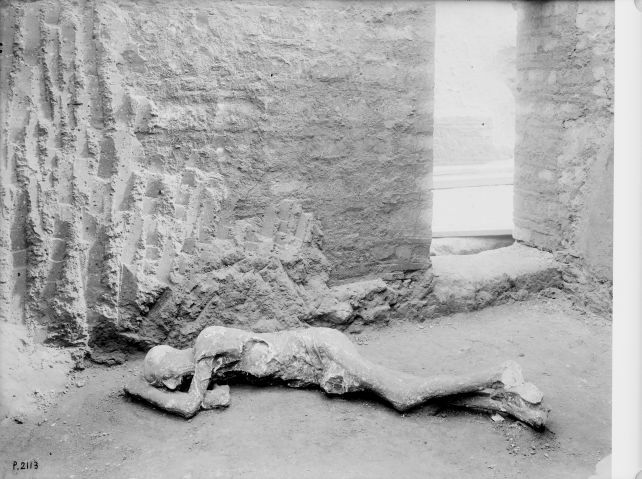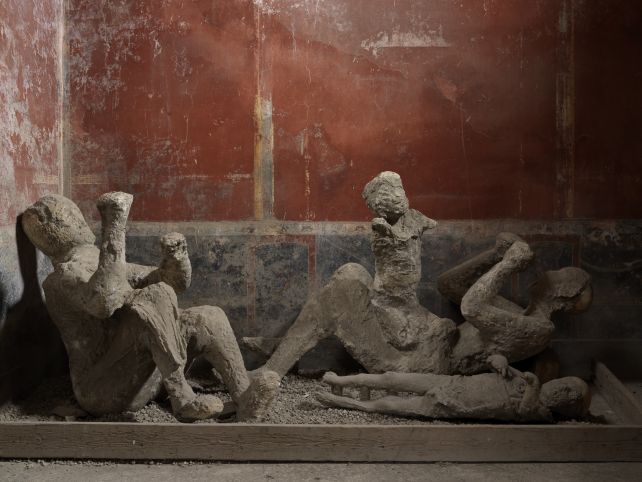The devastation of Pompeii by the eruption of Vesuvius in 79 CE is likely one of the best-recorded disasters in human historical past. The ash and pumice that rained down preserved traces of the dying the place they fell, leaving us to guess the identities and relationships of the individuals left frozen in time.
However we people are imperfect. We navigate the world with perceptions and biases that cloud our observations, irrespective of how we attempt to stay goal. A brand new evaluation of DNA retrieved from the victims of Pompeii reveals our assumptions about them had been flawed – a discovery that’s giving us perception into the bustling lifetime of Pompeii, earlier than a volcano snuffed it out.
“The scientific information we offer don’t at all times align with widespread assumptions,” says geneticist David Reich of Harvard College.
“For example, one notable instance is the invention that an grownup carrying a golden bracelet and holding a baby, historically interpreted as a mom and baby, had been an unrelated grownup male and baby. Equally, a pair of people regarded as sisters, or mom and daughter, had been discovered to incorporate not less than one genetic male. These findings problem conventional gender and familial assumptions.”
The volcanic materials dumped on Pompeii when Vesuvius exploded acted as a type of flash fossilization course of. It fell on and across the lifeless and dying, then set in place. When the our bodies succumbed to time and decay, they left hole impressions behind ash.
The ruins had been rediscovered within the nineteenth century; within the 1870s, plaster was poured into the hollows to create casts of the our bodies that had created them. However the shapes of the our bodies weren’t the one factor preserved. The bones left behind had been additionally sealed into the plaster.
The archaeologists who made the casts within the nineteenth century could not have foreseen the emergence of future know-how; however, their work would show invaluable greater than 150 years later. That is as a result of the casts give us context for particulars preserved within the genetic make-up of the victims, which in flip helps us perceive life in Pompeii and Roman-era Italy.
The evaluation, led by forensic archaeologist Elena Pilli of the College of Florence in Italy, was performed on fragmentary skeletal stays from 14 plaster casts, chosen from 86 casts which might be presently present process restoration. That is no simple process, anthropologist Alissa Mittnik of Harvard College and the Max Planck Institute for Evolutionary Anthropology in Germany advised ScienceAlert.

“Each the intense warmth throughout the volcanic eruption and the plaster casting course of might be detrimental for long-term DNA preservation. In genetic analyses, we normally attempt to goal skeletal components which might be recognized to protect DNA exceptionally properly, such because the interior ear portion of the cranium or enamel,” she defined.
“On this examine, we needed to be much less selective, as we had been solely in a position to take samples from the elements of the skeletons that had been uncovered in broken casts that had been present process restoration. The issue of acquiring historic DNA below these circumstances is obvious in the truth that solely six of 14 sampled people supplied us with genetic information.”
However these six people had been enough to offer a major problem to what we thought we knew in regards to the victims of Pompeii.
The casts are glorious, however not good, and particulars is usually a little arduous to gauge, simply by eye, so archaeologists relied on different clues. The ostentatious golden bracelet worn by the individual embracing a baby was regarded as ladies’s jewellery. The tender affection with which every pair embraced was interpreted as female. Each of those assumptions, it seems, had been incorrect.

On the Home of the Golden Bracelet, 4 people interpreted as mother and father and their two youngsters weren’t genetically associated to one another. A minimum of one particular person within the embracing pair was a person – and sure the opposite was, too.
The findings trace at a a lot deeper, extra complicated society than we had imagined for Pompeii.
“I had encountered the standard narratives surrounding a few of these teams of victims earlier than finding out them scientifically they usually appeared believable to me, subsequently I used to be fairly shocked to see that the genetic outcomes uncovered that there’s extra to those individuals’s tales than ‘what meets the attention’,” Mittnik advised ScienceAlert.
“The findings make us rethink simplistic interpretations of gender and household dynamics in Roman society which may not mirror fashionable western intuitions.”
The analyses additionally revealed a higher genetic range in Pompeii than was suspected. The people studied had been primarily descended from comparatively latest immigrants from the japanese Mediterranean and Close to East, slightly than the individuals who had lived within the native area for hundreds of years.
That is much like range seen extra broadly throughout the Roman area of western Italy, reflecting early forays into globalization, facilitated by strengthening commerce throughout the Roman Empire.
And that is simply six people in a metropolis of hundreds. It is a staggering end result. Not solely does it give us a brand new glimpse into the lives of people that lived hundreds of years in the past, it is a sobering reminder to attempt to examine our biases on the door if we wish to conduct an correct examine of human historical past.
“Whereas our findings enable us to problem a number of the conventional narratives, we have to be cautious to not repeat the identical mistake,” Mittnik advised ScienceAlert. “As an alternative, our outcomes emphasize the significance of integrating numerous strains of proof and of not superimposing fashionable assumptions onto historic contexts.”
The analysis has been printed in Present Biology.





